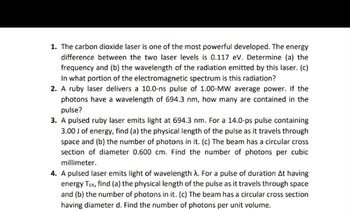Question

Transcribed Image Text:1. The carbon dioxide laser is one of the most powerful developed. The energy
difference between the two laser levels is 0.117 eV. Determine (a) the
frequency and (b) the wavelength of the radiation emitted by this laser. (c)
In what portion of the electromagnetic spectrum is this radiation?
2. A ruby laser delivers a 10.0-ns pulse of 1.00-MW average power. If the
photons have a wavelength of 694.3 nm, how many are contained in the
pulse?
3. A pulsed ruby laser emits light at 694.3 nm. For a 14.0-ps pulse containing
3.00 J of energy, find (a) the physical length of the pulse as it travels through
space and (b) the number of photons in it. (c) The beam has a circular cross
section of diameter 0.600 cm. Find the number of photons per cubic
millimeter.
4. A pulsed laser emits light of wavelength λ. For a pulse of duration At having
energy TER, find (a) the physical length of the pulse as it travels through space
and (b) the number of photons in it. (c) The beam has a circular cross section
having diameter d. Find the number of photons per unit volume.
Expert Solution
This question has been solved!
Explore an expertly crafted, step-by-step solution for a thorough understanding of key concepts.
Step by stepSolved in 2 steps with 2 images

Knowledge Booster
Similar questions
- How much energy is carried by light with a wavelength of λ = 509 nm? Express your answer in eV (electron-volts).arrow_forwardA laser beam of power 6.0 W and diameter of 2.0 mm is directed upward at a highly reflective oil droplet of density 0.85 g/cm^3. What maximum radius droplet can be levitated by the radiation pressure of the laser beam?arrow_forwardHow much energy (in eV) does a photon of red light (1 = 700 nm) have? (h=6.63 1034 Jxs, c=3.00 10³ m/s, 1 eV = 1.60 10-19 J, and 1 nm = 109 m) -9 3.11 eV 2.26 eV 1.78 eV 1.24 eV..!arrow_forward
- A laser emits 5.73 × 1015 photons per second in a beam of light that has a diameter of 2.30 mm and a wavelength of 514.5 nm. Determine (a) the average electric field strength and (b) the average magnetic field strength for the electromagnetic wave that constitutes the beam. (a) Number M. (b) Number i Units Unitsarrow_forwardA typical red laser pointer has a power output of 1.50 mW and a wavelength of 680 nm. Find how many photons per second the laser emits in units of 10¹5 photons/sec. (A) 2.31 (B) 5.13 (C) 4.97 (D) 7.49 (E) 3.78arrow_forwardThere are several proteins that exist in nature that are fluorescent, which means they absorb visible light or other electromagnetic radiation and reemit that light, usually at a longer wavelength. One of the more prevalent fluorescent proteins is GFP, or green fluorescent protein, which emits bright green fluorescent light when exposed to light in the blue to ultraviolet region of the electromagnetic spectrum (see the photo). The main absorption, or excitation, wavelength for one type of GFP is 395 nm. (a) What is the energy (in eV) of a photon in this absorbed light? The emission spectrum of the light from the GFP peaks near 509 nm, which is in the shorter wavelength (higher energy) portion of the green part of the visible spectrum. (b) What is the energy (in eV) of a photon in the emitted light? (c) If the emitted light corresponded to the longest wavelength in the Balmer series from a hydrogen-like atom, what would be the effective value of Z for this atom? (Note: Z will not be a…arrow_forward
- A helium-neon laser produces a beam of diameter 1.75 mm, delivering 3.15 x 1018 photons/s. Each photon has a wavelength of 633 nm. (a) Calculate the amplitude of the electric field inside the beam. kv/m (b) Calculate the amplitude of the magnetic field inside the beam. μT (c) If the beam shines perpendicularly onto a perfectly reflecting surface, what force does it exert on the surface? nN (d) If the beam is absorbed by a block of ice at 0°C for 2.10 h, what mass of ice is melted? garrow_forwardBy Thomson's time, it was known that excited atoms emit light waves of only certain frequencies. In his model, the frequency of emitted light is the same as the oscillation frequency of the electron or electrons in the atom. What would the radius of a Thomson-model atom have to be for it to produce red light of frequency 4.55×1014 HzHz ? (see Appendix FF from the textbook for data about the electron)arrow_forwardLight with an intensity of 10−10W/m2 is shone perpendicular to the surface a metal that has one free electron per atom. Distance between atoms approx 2, 6A˚. Based on the notion of light as a wave and the assumption that light evenly distributed over the entire metal surface, (a) how much energy each electrons per second? (b) if the electron binding energy is 4.7eV , how long does the electron collect energy to escape the metal surface?arrow_forward
- How fast must an electron be moving if all its kinetic energy is lost to a single x-ray photon with the following characteristics? (a) The photon has a wavelength of 3.55 x 10-8 m near the high end of the x-ray electromagnetic spectrum. Your response differs significantly from the correct answer. Rework your solution from the beginning and check each step carefully.c (b) The photon has a wavelength of 3.55 x 10-13 m near the low end of the x-ray electromagnetic spectrum,arrow_forwardA housing attached to a microprocessor uses radiator fins to get rid of excess heat. If the largest amount of radiation emitted by the fins has a frequency of 186.20 THz, what is the associated wavelength? marrow_forward
arrow_back_ios
arrow_forward_ios